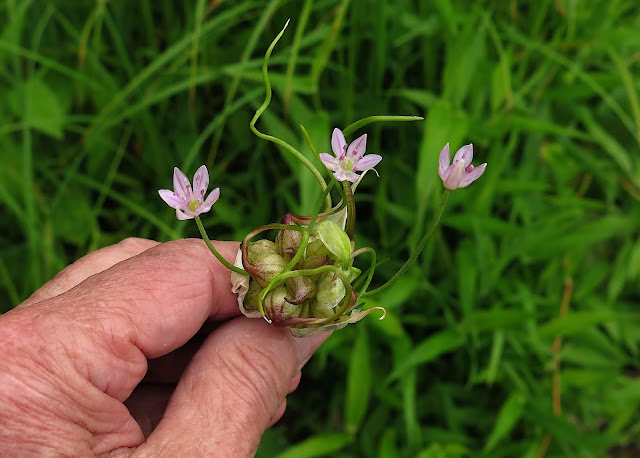When I came here on Tuesday to preview our walk, the sky was blue and sunshine glittered on the Hudson's ripples. In this view, I am looking downstream toward Mechanicville, with the Hoosic entering the Hudson on the left. Abundant rainfall over the past few months had turned both rivers full and swift and brown.
One of the Canal Park trails starts on the banks of the Hudson, where trees lean over the river from the heights of steep rocky cliffs and mosses cover the ground. Another trail leads directly into the woods.
One of the more interesting shrubs along this trail is called Deerberry (Vaccinium stamineum). Related to blueberries, this shrub bears small white flowers with protruding brown stamens.
Deerberry flowers can be immediately differentiated from blueberry flowers by being more spreading and open. The protruding needle-thin pistil and long brown stamens are also distinctive.
The Deerberries grow in the shade of the woods, while the flower in the photo below -- Foxglove Beardtongue (Penstemon digitalis) -- grows out on the sunny banks at the confluence of the two rivers.
Abundant numbers of Hairy Bushclover (Lespedeza hirta) also grow in this sunnier area (although there was more rain than sun when I took this photo on Thursday). Several other species of Bushclover grow at Canal Park, including the rare Creeping Bushclover (L. repens), which will bloom later in the summer.
When the trail turned to follow the Hoosic River, I was impressed by how brown and turbulent the water was as it rushed along below the steep banks.
I promptly noticed that patches of Frostweed (Crocanthemum canadense) grew close to the trail as I started walking upstream. It's pretty hard to miss these bright-yellow blooms with their orange-tipped anthers.
On the other hand (and also on the other side of the trail), I had to search to find these miniature plants of Sheep Laurel (Kalmia angustifolia), despite how vividly colored their flowers are. Grasses and low blueberry shrubs had grown up around them and hid them quite effectively.
Eventually, the trail leads down to a low alluvial area, where seasonal floods bring silt to enrich the soil. Plants grow huge and healthy here, and the view of the landscape upstream is very picturesque.
Huge Sycamores, Cottonwoods, and Silver Maples tower over the rich bottom land.
Here is the plant we come here each year to visit: Green Dragon (Arisaema dracontium), grown to enormous size in this rich alluvial soil. Although the New York Flora Association Plant Atlas indicates this is not a rare plant, neither I nor any of my Thursday Naturalist friends have found it anywhere else but here.
It was about 5 years ago that we found a single specimen of Green Dragon at this site. Now, they flourish in nearly uncountable numbers and grow to prodigious size.
I always return to this site later in summer, when these purple-topped Spotted Joe Pye Weeds (Eutrochium maculatum) will reach a towering height and be crowned with puffs of dusty-rose flowers. Here, too, will grow Giant Ragweed that lives up to its name, and several other midsummer wildflowers that grow to impressive size in this rich soil.
And here was a tiny little flower that equally impresses me, such dainty little pink blooms erupting from the bulblet pod of a Canada Onion plant (Allium canadense). This plant doesn't take any chances when it comes to reproduction, producing both clonal bulblets as well as flowers that will sexually produce seed through pollination. And aren't they pretty? Hard to believe they're an onion!
Here was another tiny flower that's remarkably pretty, although it is not a native plant like that of the Canada Onion. Three years ago, I found this one wee little Kenilworth Ivy plant (Cymbalaria muralis) tucked into a niche in a steep shale bank, and to date it has not budged from that niche nor appeared anywhere else along these banks. For an introduced plant, it seems remarkably non-invasive, at least at this location.
Unfortunately, the same cannot be said for this equally pretty introduced plant, the Yellow Flag (Iris pseudacorusis). A wetland plant that is extremely showy, the Yellow Flag colonizes in large masses, forming very dense stands and outcompeting other wetland plants. Its appearance in this site so rich in unusual native plants is a great cause for concern. I hope I can influence some invasive-species management folks to come here to eradicate the many plants that are beginning to colonize this site. The roots are very difficult to dislodge, so it will take quite an effort to remove the plants.
This photo below shows how the Yellow Flag has colonized a low area on the Hudson River banks just across from Lock 4. I truly hope this is not what the future holds in store for the site we Thursday Naturalists visited today.



















3 comments:
I love reading your blog, Jackie! So much good information and plant identification along with great photos! Thank you for this!
Lots of neat plants! I don't think I've ever seen masses of Yellow Flag like that.
Interesting flora at that site. Down here the yellow flags are quite common but with only a few exceptions don't dominate any sites.
Post a Comment